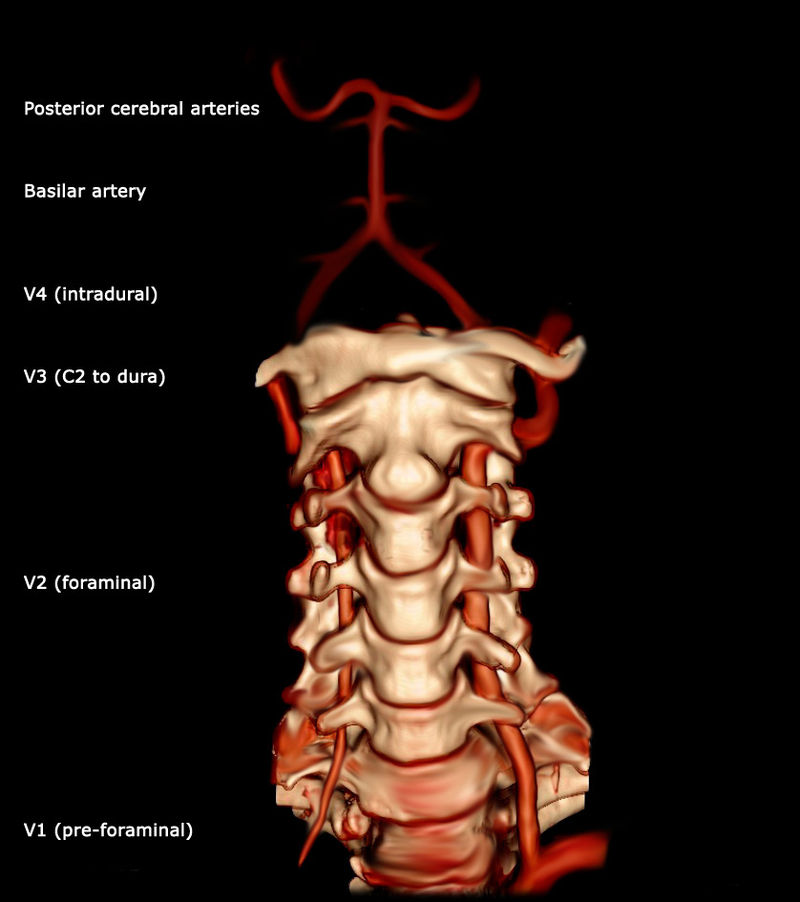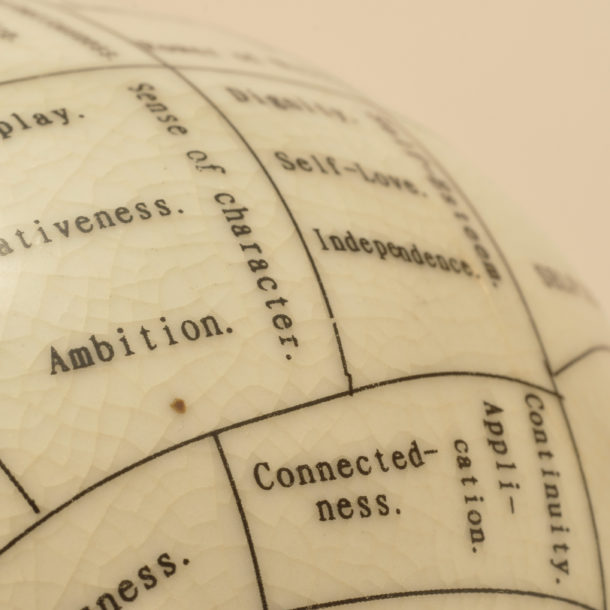The Brain Is Not a “Meat Computer”
Dramatic recoveries from brain injury highlight the differenceEarly in my neurosurgical career, I was called to the emergency room to see a four-year-old boy who had had a stroke. He was playing on a sofa and fell on his head, twisting his neck. He told his mom that his head hurt—then lapsed into a coma.
The CT scan showed that he had torn his vertebral artery, which is a vital artery that traverses the bones of the neck and provides blood flow to critical parts of the brain (see the illustration at right below). His damaged brain was swelling dangerously; quite simply, he was dying.

Vertebral artery based on 3d surface rendered CTA/Frank Gaillard (CC BY-SA 3.0)
We rushed him to the operating room, where I removed the permanently damaged part of his brain—most of his left cerebellar hemisphere—to take the pressure off of his brainstem so as to save his life. The cerebellum plays an important role in coordination so I had to tell his family that he would likely be handicapped, both from the stroke and the need to remove the damaged part of his brain.
The materialist view that the brain as a computer made of meat and that the mind is the software run on this carnal machine is a profound misunderstanding of neurology and of the relationship between the mind and the brain.
He survived, and in fact, he did quite well. Several weeks later, during a follow-up visit in my office, I could find no neurological deficit at all. He was a normal child, albeit missing most of his left cerebellar hemisphere.
I heard from him years later, after he had grown up and gone on to college. He sent me a photo of himself—on his NCAA college basketball team. He was a superb athlete and was dreaming of a professional career.
Every neuroanatomy and neurophysiology textbook I studied as a medical student described the function of the cerebellum in terms of circuits, neural networks, and computation. It appeared unlikely that anyone could sustain even a tiny injury in such a complex “computer” and retain normal coordination, let alone superb coordination, and play a sport at a high collegiate level.
But I have learned in practice what every neurosurgeon knows, that much of the cerebellum is expendable. We remove major parts of it routinely in order to remove tumors or blood clots or to decompress the brainstem, which is immediately in front of the cerebellum, without any lasting neurological outcomes (sequelae).
Modern neuroscience is riddled with high-tech phrenology, based on materialist assumptions that the brain is a hard drive and the mind is the program that runs on it. The use of an analogy to computation to understand the brain and the mind is fraught with fallacies.
Many other parts of the brain can also be removed without discernable neurological injury. In fact, a vital aspect of neurosurgical practice is knowing which parts of the brain are ‘eloquent’—that is, they cannot be damaged without significant neurological injury—and which parts are ‘non-eloquent’ and can be removed without causing a significant neurological deficit.
Some assumptions in neuroscience are just “computational phrenology”
The recent news story about a four-year-old boy who retained quite good neurological function after removal of one-sixth of his brain should be understood in this light. The removal of that part of his brain was necessary because it was causing intractable epileptic seizures. Such surgery is quite common and can be very effective. It is common for patients, especially children, to recover quite a bit of the function that was lost with the surgery, although some brain function, such as the ability to see in all parts of the visual field, are irretrievably lost.

Removal of eloquent brain tissue is not recoverable, by definition. But much of the brain is not eloquent, and remarkable recoveries are common. The boy featured in recent news remained unable to see in part of his visual field but he compensated for it well: Neuroimaging showed evidence that the opposite occipital lobe of his brain was assuming some of the associated functions of the removed lobe.
This is good and interesting science, but not surprising to experienced neurosurgeons. The materialist view that the brain as a computer made of meat and that the mind is the software run on this carnal machine is a profound misunderstanding of neurology and of the relationship between the mind and the brain. It is akin to the error of phrenology in the 19th century when materialist neuroscientists presumed that all regions of the brain were eloquent and that complex intellectual functions could be localized to specific gyri.
The phrenologists were quite wrong— high-level intellectual function localizes very little or not at all to specific brain regions—but phrenology hasn’t really died out, despite the collapse of its evidence base. Modern neuroscience is riddled with high-tech phrenology, based on materialist assumptions that the brain is a hard drive and the mind is the program that runs on it. The use of an analogy to computation to understand the brain and the mind is fraught with fallacies.
 Thinking is not computation. In fact, thinking is the anthesis of computation. Thought always has meaning, and computation inherently lacks meaning. That is what makes computation so versatile—it imparts no meaning of its own to the tasks to which we apply it.
Thinking is not computation. In fact, thinking is the anthesis of computation. Thought always has meaning, and computation inherently lacks meaning. That is what makes computation so versatile—it imparts no meaning of its own to the tasks to which we apply it.
Quantum physicist Werner Heisenberg (left), formulator of the Uncertainty Principle, understood the dangers inherent in approaching scientific questions with ideological blinders, as materialists do with neuroscience:
What we observe is not nature itself but nature exposed to our method of questioning. – Physics and Philosophy: The Revolution in Modern Science (1958)Werner Heisenberg, Physics and Philosophy: The Revolution in Modern Science, 78.
The brain looks like a computer only if we analyze it as if it were a computer. Our analysis does not mean that it is a computer, and it does not mean that computation explains the mind or even that computational approaches to neuroscience provide genuinely meaningful insight into neurophysiology.
‘Computational’ phrenology is just the 21st-century iteration of 19th-century pseudoscience.
See also: Boy loses large hunk of brain. And is “doing just fine.” When pundits talk glibly of creating artificial minds or claim that consciousness is an illusion, it might help to remember that few people predicted that cases like this could exist and few thought that high tech diagnostics would lead to their discovery.
and
Neurosurgeon outlines why machines can’t think: The hallmark of human thought is meaning, and the hallmark of computation is indifference to meaning.
